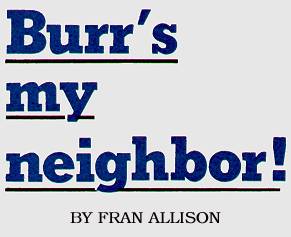
IT'S JUST two blocks away from my own home, but I
paid my first visit to
Burr Tillstrom's new quarters after every last cup,
saucer and spoon was
in place. I had no intention of being un-neighborly, but
there's a limit
to the amount of construction commotion any woman can
stand, and for the
past year, I've been caught squarely between two Mr.
Blandings, each building
his dream house.
When
men begin taking houses apart and putting them together
again in their own pattern, they certainly go all
out. At home, my husband, Archie, glancing up from
his newspaper, would stare fixedly at the wall and
remark, "Now do you think we should have paint, paper,
or knotty pine?"
Studio
conversation was parallel. In the midst of a story
conference, Burr would suddenly get the same far-away
look in his eyes and ask, "Fran, should my furniture be
last-word modern, or should I stick to antiques?"
Burr
got the remodeling fever largely because Kukla and Ollie
outgrew both an apartment and an office. To those of you
who are off the coax or kine, I should explain that
although Kukla and Ollie officially are puppets, they
and the rest of the Kuklapolitans have such lively,
fully developed personalities
we, who work with them or watch them, are very sure they
are real.
In the studio, we always refer to them as "the kids."
 Being real, they have wants just as
demanding as any human's.
If Kukla needs a new train, or Ollie requires a prop for
a pageant, some
one has to make the things and that requires workshop
space.
Being real, they have wants just as
demanding as any human's.
If Kukla needs a new train, or Ollie requires a prop for
a pageant, some
one has to make the things and that requires workshop
space.
They
also have sponsors, sponsors have advertising agents,
and all of them like to sit down and talk things over
with Burr in a spot where phones don't
ring every five seconds. The staff, too, needs
dream-up time. The staff
consists of Beulah Zachary, producer; Lewis Gomavitz,
director; Jack Fascinato,
musical director; Joseph Lockwood, costume designer, and
Mary Dornheim and
Cathy Morgan, our secretaries. We're a
tightly-knit group, we like
each other and we spend much more time together than the
cast and staff of
most shows.
His own
home would not serve. The apartment near the
Evanston boundary, comfortable and just the right size
for Burr and his parents, Dr. and Mrs. B. F. Tillstrom,
has, on occasion, stretched to accommodate the whole
crew, but its chief handicap has been distance.
The
Tillstroms, to add an extra hour to Burr's day, decided
to buy into a
cooperative apartment now under construction close to
the studio, but that
still left Kuke and Ollie homeless. It would, Burr
concluded, be a
nice idea to find them a coach house of their own.
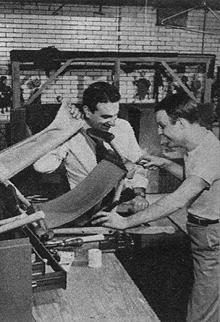 Archie
and I have a coach house, too, and that's how I happened
to spend the last
year as chief listener to two Mr. Blandings.
Archie
and I have a coach house, too, and that's how I happened
to spend the last
year as chief listener to two Mr. Blandings.
We
moved into ours at the end of the war when my husband
stowed away his uniform
and returned to being Archie Levington, publisher's
representative for Leeds
Music Company. His work requires that he spend
most of his evenings
calling on orchestra leaders and vocalists. At the
same time, my eight
a.m. date as Aunt Fanny on the Breakfast Club, meant I
must be up early.
We
solved our problem by buying this coach house on
Chicago's near north side,
close to the loop and the studios. Our predecessor
had remodeled and
furnished it, so all my mother Nan, and Archie and I had
to do was hang up
our clothes, buy some groceries and set up
housekeeping. A year later,
when Kukla, Ollie and company became a part of our
lives, it turned into
a convenient gathering place.
Burr
wasn't so lucky, for after the time we bought, coach
houses became fashionable.
Others, too, were discovering how convenient they
were, and the few
existing ones were snapped up fast. For more than
a year, Burr searched,
but none of those that were available met any of his
requirements.
I
thought he had just about given up when, one day, he
rushed into our place
sounding very much like Ollie in the throes of a major
enthusiasm. Breathlessly,
he told us, an agent who was a fan of the show heard
Burr was house hunting
and got in touch with him. (Kukla and Ollie win
the hearts of the nicest
people.) Located down State Parkway a little ways,
it was almost equidistant
from our place, Beulah's and Joe Lockwood's. Other
members of the staff and
many of Burr's friends also lived nearby.
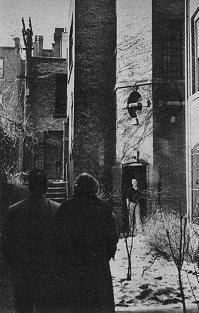 It
even looked romantic, Burr reported. To enter, you
went down some steps,
walked through a narrow passage, and there it was, like
a miniature one-turret
castle facing a tiny garden. Of slightly later
vintage than ours, its
first floor where the high-wheeled limousines once had
stood would make an
ideal place for both workshop and puppet theater. The
basement below gave
additional storage space.
It
even looked romantic, Burr reported. To enter, you
went down some steps,
walked through a narrow passage, and there it was, like
a miniature one-turret
castle facing a tiny garden. Of slightly later
vintage than ours, its
first floor where the high-wheeled limousines once had
stood would make an
ideal place for both workshop and puppet theater. The
basement below gave
additional storage space.
Since
Burr sounded like Ollie, I began to suspect an Ollie
gimmick was involved
somewhere. A little impatiently, I asked, "What
about living space?
How many rooms do you have on the second floor?"
"One,"
said Burr blandly, "but it's huge. It used to be
the recreation room. There's a terrific fireplace,
high enough to stand inside, and
the floor is wide oak planking fastened together with
wedges."
It
sounded great, but Burr wasn't through yet. "Of
course," he confessed, "I'll have to do a little
remodeling, such as building a bathroom, a kitchen, and
a stairway from the first floor."
Altogether, it sounded like an appalling amount of
remodeling to me, but Archie's
reaction was just the opposite. That's when his
speculative look appeared
for the first time as he said, "Now I think that's just
fine. You're
always better off when you start at the beginning and
rebuild it to suit
yourself I wish we had done that here."
I was
remembering how grateful I'd been to get a roof over our
heads during the worst of the housing shortage, but
Archie was glancing around our living room as though he
were taking inventory. "Yes," said Archie, "we
could
make a lot of improvements. There's space wasted
by that big dining
room when what we need is a guest room. The kitchen is
too small, too.
When Nan and Fran both are in there, I haven't got
enough room left to get
to the stove to see what's cooking."
"Burr's
given me an idea. I think this would be a good time to
start remodeling this place, too."
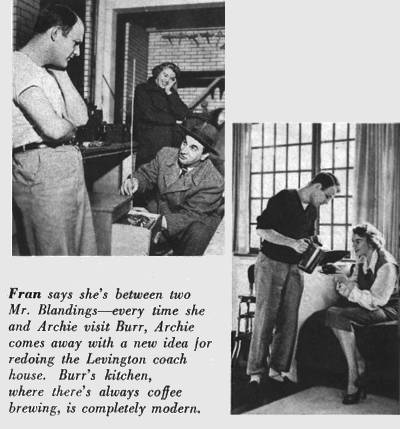 Archie and Burr had a magnificent time
advising each other about
contractors, recommending decorators,
choosing household equipment,
and the accomplished results are wonderful, but it
certainly kept us all
upset.
Archie and Burr had a magnificent time
advising each other about
contractors, recommending decorators,
choosing household equipment,
and the accomplished results are wonderful, but it
certainly kept us all
upset.
It's
been worth the wait. Burr's decorating scheme is
both effective and livable. You enter through the
garden door, climb a tiny narrow staircase, and arrive
first in the workshop and puppet theater. That's
the utilitarian section, the place where Burr, the
genius at creating new characters, turns into B.
Tillstrom, skilled technician. There's a
well-equipped work bench along one side, and across the
back are miniature stages. At present he is
interested in developing a new show which will
have marionettes, the string operated puppets, rather
than hand puppets like
the Kuklapolitans. It's one of those things which
will see the light
of day only when Burr, who lives with his characters,
has dreamed up the
final facet of personality of the least important
marionette, and until then,
they'll dangle from their stands behind the stage sets.
Kukla, at present, has
only one evidence of his residence. To get to the
stairs you have
to walk around his miniature railroad system which
stands on trestles in
the middle of the floor. Burr, of course, is just
as much of a railroading
enthusiast as Kukla, but when he gets extravagant about
equipment, he always
justifies the expenditure by saying he bought it for
Kuke.
Yes,
Burr built the stairs. The treads are covered with
hemp matting, and presiding over the first landing is a
huge spread-winged golden
eagle, carved of wood. No story accompanied it
when he purchased the
creature in a New England antique shop but Burr is
certain it must once have
graced the prow of a clipper ship.
In the living section Burr has achieved a
skillful blend of modern
and ancient. Two Lawson sofas, upholstered in
brown, face one of the
biggest coffee tables I've ever seen in my life, and the
white wool shag
rug beneath them is strictly 1951 American. The
side tables however,
are at least a hundred years old, and on them are lamps
made from Cathay-trade
tea canisters.
The
floor is stained dark, the walls are white, and the draw
curtains at the
casement windows are plain yellow. Along one side
of the room, an antique
mirror hangs over a long side table. Flanking it
are a pair of old
high-backed, carved chairs. Across from them,
there's an antique chest
which holds table linens. The piano fits into a nook at
the head of the stairway.
As Burr
still really lives with his family, he didn't build a
bedroom. Instead, at the far corner of the floor,
he placed two studio couches at right
angles with a square storage cabinet built between
them. Nights when
he chooses to stay at the coach house, or use it as
quarters for out-of-town guests, deep innerspring
mattresses assure comfortable sleep, and by day, banked
with big square bolsters and attired in slip covers, the
beds turn into grandstands for those who kibitz those
who are cooking.

The kitchen unit is
directly opposite. It's strictly a bachelor's
kitchen. Archie built almost the identical one for
me, and I've found it saves steps and work,
so I'm all in favor of design by those who have no
intention of making a
career of housekeeping. They have a trick of
reducing it to the simplest
common denominator.
Stove,
sink and automatic dishwasher line the wall. Above
them are white
enameled cabinets - for dishes. At the side, there's a
set of low shelves.
A small work table rolls on casters to the spot where it
is needed.
Burr
used the small hallway built between the kitchen and
bathroom to construct an additional closet. Flat
and shallow against the wall, it holds cleaning
equipment and a folding table which is labeled "for
canasta" but which actually
doubles in a multitude of uses.
The
bathroom is something. Serving as dressing room
also, its floor is covered with a cotton shag rug of
mixed brown and white. The double dresser is
gray-beige enamel and above it is a huge mirror.
Although the mirror appears extravagant it actually is
utilitarian, for there's where
Burr rehearses Kukla and Ollie. He tells me that
his best ideas always
come while shaving. When a brainstorm strikes,
he'll drop his razor
and turn puppeteer. Manipulating his hands before that
mirror, he'll work
out things which he wants Kuke and Ollie to do on the
show.
Burr
frequently invites Archie and me to come over and just
visit, but enjoyable
as that is, the times I like best are those when the
staff gathers around.
Archie joins us and we all relax, do as we choose, and
have fun.
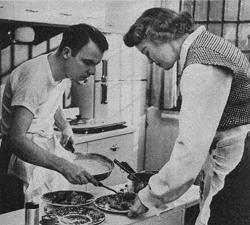
Festivities
usually start with Mary filling the percolator,
for we're all
terrific coffee drinkers. Gommy and Archie set
up the motion picture projector. The
white, uncluttered wall serves as a screen, and
soon we all sit back, coffee cup in hand, to
watch the kinescope recordings of past shows.
Just about
then some one decides to cook. When Burr
officiates, it's usually chicken and rice
pilaff because he knows I love it.
Again, keeping
things as simple as possible, he always buys
the cut-up chicken so that all
he has to do is open the package, roll the
pieces in flour, and brown them
in a frying pan holding a half-and-half
mixture of butter and shortening.
As soon as they reach that golden brown
crusted stage, he adds about a half
cup of water, covers the pan and turns down
the flame to let the chicken
simmer slowly.
|
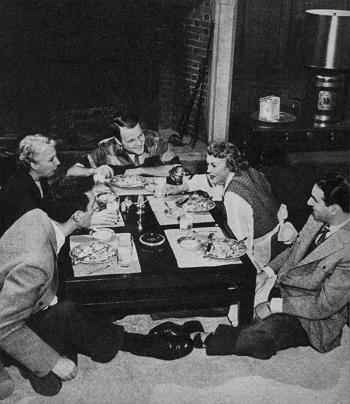 The
pilaff is an Armenian dish which one of Burr's
former girl friends taught
him to make. You start it by browning a
package of cooked fine noodles
in four tablespoons of butter. Wash one
cup of uncooked white rice
and put it in a pan with two cups of
water. When it is hot, mix in
the noodles, add salt and pepper, set on a
medium flame, put the lid on the
pan, and don't touch it for thirty or forty
minutes. The
pilaff is an Armenian dish which one of Burr's
former girl friends taught
him to make. You start it by browning a
package of cooked fine noodles
in four tablespoons of butter. Wash one
cup of uncooked white rice
and put it in a pan with two cups of
water. When it is hot, mix in
the noodles, add salt and pepper, set on a
medium flame, put the lid on the
pan, and don't touch it for thirty or forty
minutes.
Nothing could
be more informal than the way the meal is
served. Because he's the tallest, Joe
Lockwood takes down the dark pottery plates
and places them on the low shelves, ready for
dishing up. Whichever one of
us is most ambitious gathers up the magazines
from the coffee table and puts
on straw place mats and silver. Then we
plunk down and sit on the floor,
backs against the sofas. Conversation
stops while we eat, for all of
us like good food.
It
flares up again as the plates are cleared and
the ice cream
and the coffee comes on. Little Cathy
Morgan curls up with a magazine.
Gommy fetches the corn popper, Mary gets a
bowl and butter, and with such
fare, the party goes for hours.
|
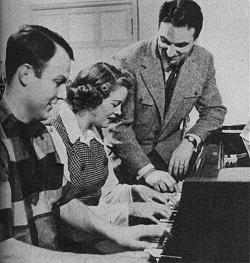
Inevitably, we all
gravitate toward the piano. Perhaps
Archie has a tune which is
just being introduced, or Jack Fascinato has a
new composition, or perhaps we all have an
urge to sing "Sweet Adeline." Secure in
the isolation of the coach house, we raise our
voices and laugh as loudly as we please,
knowing we're not disturbing neighbors in the
next apartment.
Burr calls the
place his hideaway, but from the way everyone
who visits there
has fun, I wouldn't be surprised if it turns
out to be the secret place which
has a well beaten path to its door.
|
 Being real, they have wants just as
demanding as any human's.
If Kukla needs a new train, or Ollie requires a prop for
a pageant, some
one has to make the things and that requires workshop
space.
Being real, they have wants just as
demanding as any human's.
If Kukla needs a new train, or Ollie requires a prop for
a pageant, some
one has to make the things and that requires workshop
space. 
 Archie
and I have a coach house, too, and that's how I happened
to spend the last
year as chief listener to two Mr. Blandings.
Archie
and I have a coach house, too, and that's how I happened
to spend the last
year as chief listener to two Mr. Blandings.
 It
even looked romantic, Burr reported. To enter, you
went down some steps,
walked through a narrow passage, and there it was, like
a miniature one-turret
castle facing a tiny garden. Of slightly later
vintage than ours, its
first floor where the high-wheeled limousines once had
stood would make an
ideal place for both workshop and puppet theater. The
basement below gave
additional storage space.
It
even looked romantic, Burr reported. To enter, you
went down some steps,
walked through a narrow passage, and there it was, like
a miniature one-turret
castle facing a tiny garden. Of slightly later
vintage than ours, its
first floor where the high-wheeled limousines once had
stood would make an
ideal place for both workshop and puppet theater. The
basement below gave
additional storage space.  Archie and Burr had a magnificent time
advising each other about
contractors, recommending decorators,
choosing household equipment,
and the accomplished results are wonderful, but it
certainly kept us all
upset.
Archie and Burr had a magnificent time
advising each other about
contractors, recommending decorators,
choosing household equipment,
and the accomplished results are wonderful, but it
certainly kept us all
upset. 

 The
pilaff is an Armenian dish which one of Burr's
former girl friends taught
him to make. You start it by browning a
package of cooked fine noodles
in four tablespoons of butter. Wash one
cup of uncooked white rice
and put it in a pan with two cups of
water. When it is hot, mix in
the noodles, add salt and pepper, set on a
medium flame, put the lid on the
pan, and don't touch it for thirty or forty
minutes.
The
pilaff is an Armenian dish which one of Burr's
former girl friends taught
him to make. You start it by browning a
package of cooked fine noodles
in four tablespoons of butter. Wash one
cup of uncooked white rice
and put it in a pan with two cups of
water. When it is hot, mix in
the noodles, add salt and pepper, set on a
medium flame, put the lid on the
pan, and don't touch it for thirty or forty
minutes.
